Purpose
The purpose of this activity is to support students in solving problems that require the addition and subtraction of decimals.
Achievement Objectives
NA4-2: Understand addition and subtraction of fractions, decimals, and integers.
NA4-6: Know the relative size and place value structure of positive and negative integers and decimals to three places.
Required Resource Materials
- Decimats (Material Master 7-3)
- Place value mat (photocopied to A3 size)
- Scissors
- Calculators
Activity
- Pose addition problems involving decimals. Begin with numbers with one decimal place to establish principles of renaming, such as 1.8 + 2.5 = [ ].
- Make 1.8 and 2.5 with decimats and arrange the place value parts (i.e. ones and tenths) on the Place Value mat.
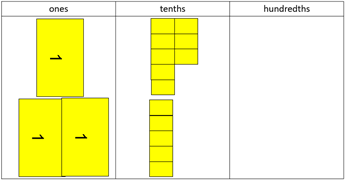
If we join these decimals, what number do we get? - Look for students to explain that combining eight tenths and five tenths makes 13 tenths that can be renamed as one and three tenths.
- As you work, you might introduce relevant te reo Māori kupu, such as the words for numbers and words related to decimals (e.g. tau ā-ira - decimal number).
- Model the combining of the numbers with the decimat parts and the place value mats. 1.8 + 2.5 modelled with ones and tenths decimats results in 3 ones + 13 tenths. Show this, then exchange 10 of the tenths for another one decimat. Add this to the ones column, and emphasise that the three tenths have remained in the tenths column.
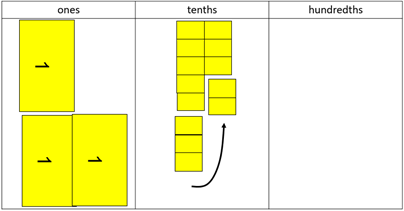
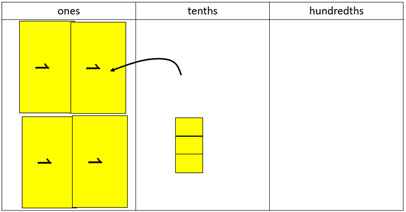
- As you work, record the calculation to match the decimat model. Although you might initially do this using an expression like 2.8 + 1.5 = 3 + 13 tenths = 3 + 1.3 = 4.3, you should progress towards using vertical written algorithms, as shown below:

Use questioning to develop understanding of the place value movements that occur at each stage of the vertical written algorithm.
What does the small one above the two mean?
Where does that extra one come from?
Use a calculator to confirm the answer.
- Provide other addition examples, progressing to decimals with two places, and then three places. Try to include numbers where renaming is needed and where it is not.
Such as, make 1.67 and 1.24 with decimats.
If we join these decimals, what number do we get?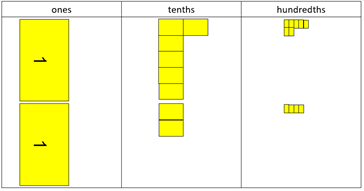
Look for students to explain that combining seven hundredths and four hundredths makes 11 hundredths, which can be renamed as one tenth and one hundredth. Six tenths and two tenths make eights tenths, and the extra tenth does not require any renaming in the tenths place. Model the actions with the decimat parts.
- Record the calculation in working form vertically to match the decimat model.

Use questioning to develop understanding of the place value movements that occur at each stage of the vertical written algorithm.
What does the small one above the six mean?
Where does that extra one come from?
Use a calculator to confirm the answer.
- Progress to subtraction with renaming. Begin with decimals to one place to establish the principle of decomposition. Use examples, such as write 2.3 – 1.9 = [ ].
Make 2.3 with decimats and place the parts on the place value mat.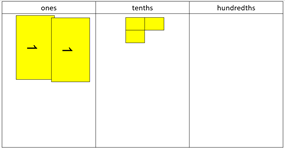
If I subtract 1.9 from this number, what do I get?
Establish that changing two point three into one point thirteen (13 tenths) is renaming 2.3 in a different form.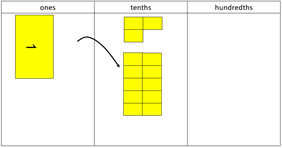

Take away the 1.9. Connect the actions with a written expression, preferably as a vertical algorithm. Check the calculation with a calculator.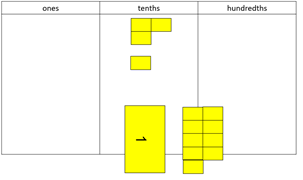

- Progress to subtraction decimals with two and three places. Examples might include:
- 3.26 – 1.53 = 1.73
- 2.08 – 0.64 = 1.44
- 2.672 – 1.555 = 1.117
Next steps
- Progress from using materials to working only in written form. This might involve first estimating the answer, then checking it with a calculator.
- Explore different real-life measurement contexts in which decimals are added or subtracted.
- There are two bags of flour. One holds 1.6 kilograms and the other holds 2.5 kilograms. How much flour is in the two bags altogether?
- You have a length of rope that is 3.46 metres long. You cut off 1.8 metres to make a skipping rope. What length of rope is left?
- Two swimmers race freestyle over 50 metres. One records a time of 23.72 seconds and the other records 25.19 seconds. What is the difference in the times?
Add to plan
Level Four